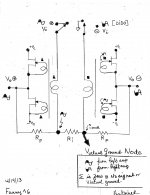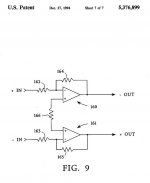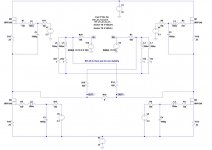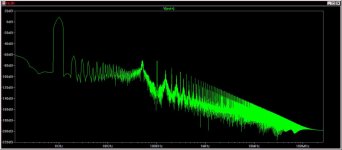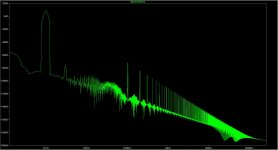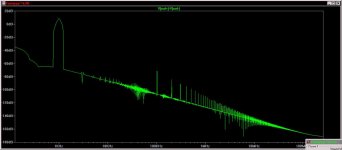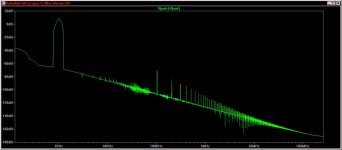That's what I am doing, other than F5T GB. I do wonder about HF, but difference between speakers is big and makes it hard to tell. Watching Grimm, with the kids at the moment.🙂
That's what I am doing, other than F5T GB. I do wonder about HF, but difference between speakers is big and makes it hard to tell. Watching Grimm, with the kids at the moment.🙂
no spoilers for us left coasters 😀
I wreote several times ;
in regular F6 , we are having two resistors for feedback net , making voltage divider , connected to bottom of input xformer coil , working in phase with input signal ....... in that way that positive (input) going signal on top of coil is decreased with (smaller) positive going feedback signal on bottom of coil
smaller resistor in feedback net is connected to gnd
if you take two channels of F6 and feed them with antiphase signals , you'll have bridged amp , for load connected to their positive outputs
imagine two (smaller) feedback resistors connected together on lower end, and then to gnd ;
now imagine their common node disconnected from gnd - now they both are acting as virtual gnd to other one , because signal going through each is antiphase to signal through other one ; their common node is still sitting on gnd potential , even if being floating in nature ; voilla! _ you have bridged circuit , with error correction - feedback is X-ed ........ through that node and also through common interaction of xformer coils
that's the same in nature as tail point in SUSY connected LTP ; famous McMilan resistors for SUSY Alephs ( and similar circs ) are having duty of decreasing any possible potential fluctuating in that point , in other words - increasing circuit symmetry
just conclusion - AC voltage in that point is exact measure of circuit assymetry ( and that's error , per se )
buzz can implement McMilan resistors in his Funny^6 too
edit : for reference , Buzz's Funny^6 sch attached :
editedit: attached edited and properly shrinked pic
The following hopes to add detail to Zen Mod's above post. The attached picture is a schematic of Funny^6. Its inputs are driven by either differential signals or with one signal to the Left amp and none to the Right amp [depicted] . Either way the power output signals of Funny^6 have equal amplitudes and are 180 degrees out phase with each other.
Suppose that the the power output signal of the left amp is spurious distortion; meaning it has amplitude and some absolute phase. The left amp infects the right amp with distortion at the summing junction. The right amp then counters by generating an equal amplitude and an out-of- phase signal to null this infection; or it creates the shown virtual ground node. Thus, the power output distortion signal of the right amp has to be equal in amplitude and 180 degrees out of phase with the left amp. Connect a loudspeaker between the two power outputs and the differential distortion signal passes right through loud and clear.
I fully agree with the Zen Mod's post; except for this critical point. Funny ^6 lacks the ability to null distortion and instead augments it. This is a good side effect since Pass amps thrive on some level of agreeable distortion.
Attachments
Last edited:
Very intetesting.
If i get chance, ill measure today. If it does little to null distortion, I would bet it has more to do with single gain stage vs a two stage design, sorta like ZenV6
If i get chance, ill measure today. If it does little to null distortion, I would bet it has more to do with single gain stage vs a two stage design, sorta like ZenV6
Last edited:
....
I fully agree with the Zen Mod's post; except for this critical point. Funny ^6 lacks the ability to null distortion and instead augments it. This is a good side effect since Pass amps thrive on some level of agreeable distortion.
without sim or actual build and test , I wouldn't be so sure about it
however - it's too early time of day for me (19.00) , to even start thinking
without sim or actual build and test , I wouldn't be so sure about it
however - it's too early time of day for me (19.00) , to even start thinking
Zen Mod. The following excerpt from US 5,376,899 discusses Figure 7 [in it] which is Funny ^6.
FIG. 7 shows two gain stages 14 and 15 coupled together by a resistor 16 across their respective negative feedback terminals. The amplifier accepts both balanced and unbalanced inputs and produces a balanced output. It does not reject the common mode signal, but neither does it amplify it. The distortion and noise contributions of both amplifiers will show in both outputs with opposite polarity so that they will not be removed differentially at the load.
Best regards
are you sure that F6 is not having feedback operation as inverting OP cell , so Funny^6 is more likely as Fig.9 in same patent ?
as I wrote somewhere - portion of output signal is opposed directly to input signal , not on some other signal node in amp .....
as I wrote somewhere - portion of output signal is opposed directly to input signal , not on some other signal node in amp .....
Attachments
are you sure that F6 is not having feedback operation as inverting OP cell , so Funny^6 is more likely as Fig.9 in same patent ?
as I wrote somewhere - portion of output signal is opposed directly to input signal , not on some other signal node in amp .....
F6 is a non-inverting amp = OP cells 14 and 15 in Figure 7. Fig 7 fits better Funny^6 than Fig 9. In Fig 7,
- ground the -IN input on OP 15
- input signal a +IN of OP 14.
- OP 14 is non inverting amp.
- The fed back signal from OP 14 to its inverting port is now the input signal to the inverting port of OP 15; which is a virtual ground.
- The phase of the out signal from OP 14 is + and the phase of the out signal from OP 15 is -. We have augmentation and not cancellation of power outputs from a single input signal [SIDO] which is identical to a DIDO.
after first evening coffee , I think you're having right with that ;
Funny^6 isn't SUSY , so it's not having diff. error correction ( or the other way around )
)
however - 5 coil Babelfish F6 Bal , or 6 coil one ....... or even vulgar 4 coil version is SUSY ;
though ...... big question mark is still - what will sound better - Funny^6 , or any of "my" iterations
to be SUSY or not to be SUSY .........
Funny^6 isn't SUSY , so it's not having diff. error correction ( or the other way around
 )
) however - 5 coil Babelfish F6 Bal , or 6 coil one ....... or even vulgar 4 coil version is SUSY ;
though ...... big question mark is still - what will sound better - Funny^6 , or any of "my" iterations
to be SUSY or not to be SUSY .........

Babelfish F6 Bal is an ingenious development. It is the one. Time will tell us the comparative performance of F6, Funny^6 and Babelfish F6 Bal .after first evening coffee , I think you're having right with that ;
Funny^6 isn't SUSY , so it's not having diff. error correction ( or the other way around)
however - 5 coil Babelfish F6 Bal , or 6 coil one ....... or even vulgar 4 coil version is SUSY ;
though ...... big question mark is still - what will sound better - Funny^6 , or any of "my" iterations
to be SUSY or not to be SUSY .........
Best regards
Thanks buzzforb. I do not know how to interpret your graph. Please do, and render a verdict.Here ya go
Be4st regards
Last one is 1W performance and resluting distortion spectra. In truth, I cant say, because i need the measurement of the amp in SE mode. I had posted some earlier, but i now question them somewhat. I am sending these boards off to Flocchini. I am redesigning the next set and will build them out as soon as I can. I will measure all over again, and post. I have to spend some time on my measuremtn rig. It is only test board and can be drastically improved. If my original measuremtns are correct, then the Funny^6 added higher harmonics and you are right. Interesting thins is, balanced mode did not kill 2nd harmonics, but did lower them. Bit unusual for Balanced amp, dont you think. Dunno for sure. I just like how it sounds. If Jensen can get back to me about 5 filar, I will try universal board with ZM's Babel 6. I am sure it is superior in every way.
Last edited:
Thanks buzzforb and Zen Mod for advancing this state of art/science. This social medium is fun, and educational. I'll continue to engage and contribute.
Best.
Best.
In truth I question everything(but the sound), but lets assume something's are true. If my measurements on original SE mode were correct, then Funny^6 added 3k and 5k harmonics, while lowering 2k slightly. I am somewhat skeptical of my SE measurements, as 3k and 5k were non existant, but it is possible. Thing most interesting to me if results of Funny^6 are true, you have managed to maintain SE nature of sound in balanced mode. As I said, I question it all and want to double check all. I want another amp here as well to test it in comparison. I also want to build quality test box with proper connectors and enclosure in order to reduce outside influence.
some FFTs from already seen principal sims ; outputs IRFP240 (convenience) ; ideal xformers used ( no losses) ; read pic titles if not visible in pic
sort of informative
all of them @1W/8R
sort of informative
all of them @1W/8R
Attachments
Last edited:
- Status
- Not open for further replies.
- Home
- Amplifiers
- Pass Labs
- Funny ^6
